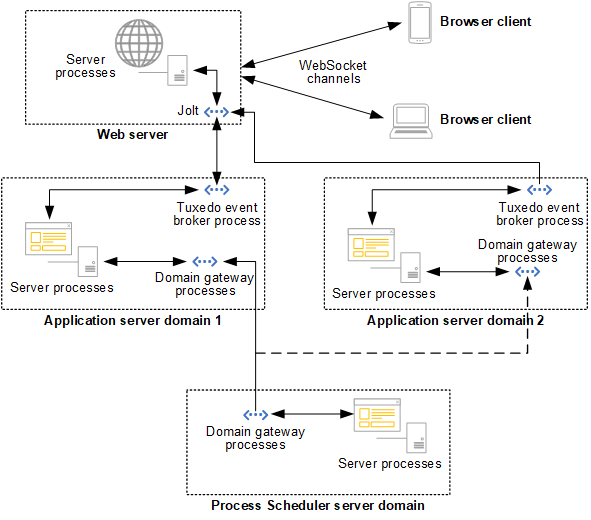Understanding the Push Notification Framework
The Push Notification Framework delivers updates to the user device with real-time changes that have occurred on the server layer. The framework enables the PeopleSoft system to push data directly to the user’s display. To bring this feature to your PeopleSoft application, PeopleTools takes advantage of these elements in our server architecture:
Tuxedo event broker on the application server.
WebSocket push technology on the web server.
The following example illustrates how the Push Notification Framework architecture operates within these layers of the PeopleSoft infrastructure:
Server layer.
Web server layer.
Browser layer

Notifications are generated on the server domains, pushed to the web server, and then on to client browsers.
Server Layer
The server layer of the Push Notification Framework includes these elements:
One or more application server domains.
(Optional) One or more Process Scheduler server domains.
(Optional) Domains gateways for inter-domain communications between the Process Scheduler server and application server domains.
If more than one application server domain is configured per Process Scheduler server domain, then the additional application server can serve as a fail-over server in the event that initial application server becomes unavailable. In the preceding diagram, this fail-over connection is depicted with a dashed line.
Event publishers.
Tuxedo event broker on the application server to route notifications to Jolt on the web server.
Web Server Layer
The web server:
Receives browser endpoint subscriptions via WebSocket.
Receives notifications routed by the Tuxedo event broker to Jolt.
Routes notifications to subscribing browser endpoints via WebSocket.
Client Layer
Notifications are routed to the clients for display to users:
Browser endpoints (the Notification window, pages, and others) are subscribed to events (or event collections).
Browser endpoints receive notifications from the web server via WebSocket.
To configure the system for push notifications, the system administrator:
Configures one or more application server domains.
Optionally, configures one or more Process Scheduler domains.
Optionally, configures a cluster environment for push notifications.
Once the system is configured, the system administrator also:
Specifies global settings.
Creates and maintains notification configurations.
Manages workflow notifications.
Archives and purges notification data.
Reviews the user data mapping configuration.
Configures inbound message handlers.
To create notifications, the application developer:
Creates event definitions.
Creates event subscriptions.
Publishes events using PeopleCode.